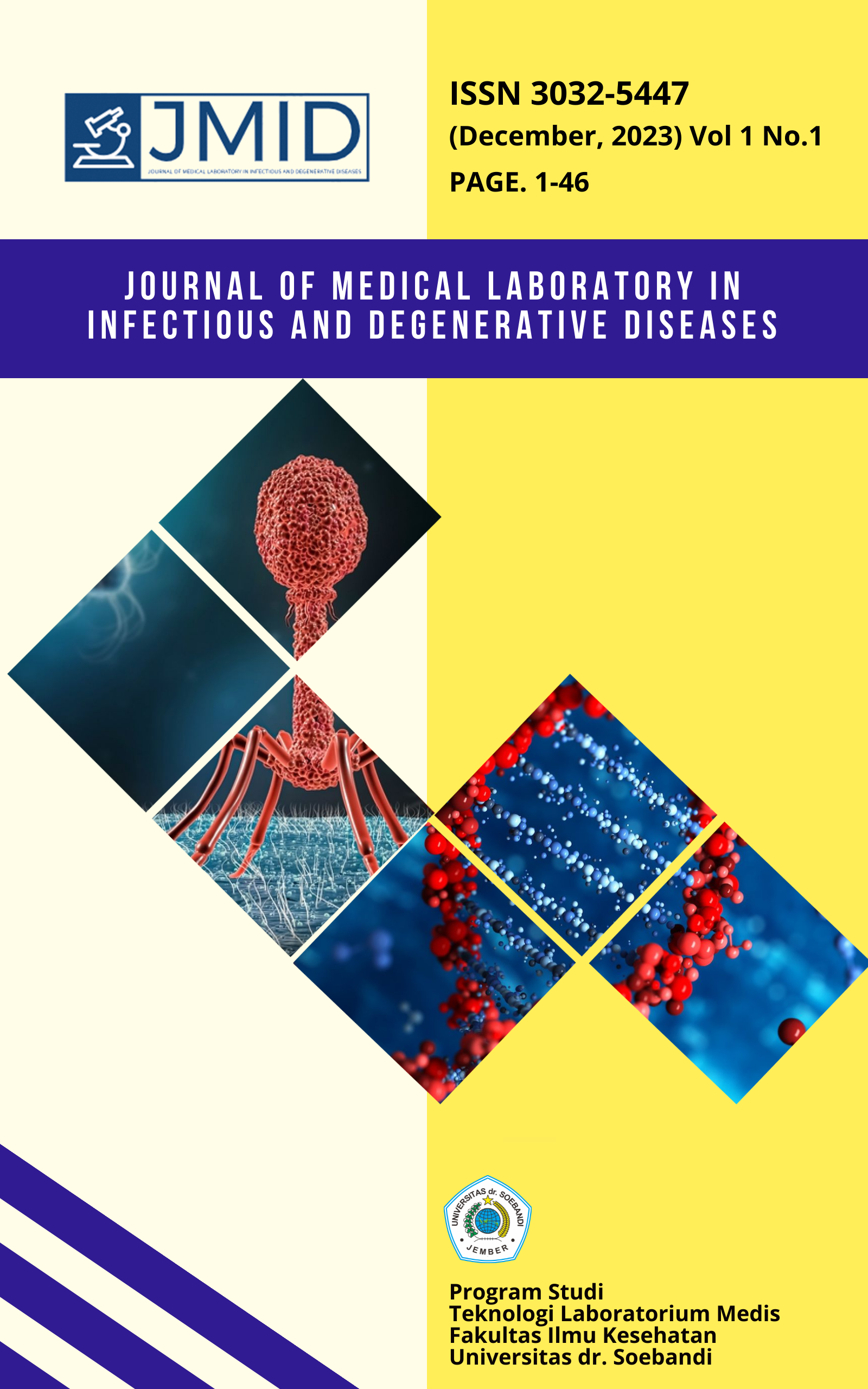Antibacterial Activity Test Of Aloe Vera (Aloe Vera) On The Growth Of Bacteries Propionibacterium acnes
Keywords:
Aloe vera, Propionibacterium acnes, AntibacterialAbstract
Background: Acne is a complex disease with elements involving bacterial growth and immunity. One of the bacteria that can cause acne is Propionibacterium acnes bacteria. Aloe vera contains compounds that can inhibit bacterial growth such as saponins, flavonoids, alkaloids, and anthraquinones.
Purpose: This study aims to determine the presence of antibacterial activity and antibacterial differences in 70% ethanol and ethyl acetate extracts of aloe vera meat against Propionibacterium acnes.
Methods: This type of research is experimental using the maceration extraction method with 70% ethanol and ethyl acetate solvents. The sample of this research is aloe vera meat extract with a concentration of 75%, 50%, and 25%. The positive control used was tetracycline antibiotic and the negative control used distilled water. The antibacterial activity test used the pitting diffusion method with millimeter (mm) measurement.
Results: The test results showed that there was antibacterial activity for ethanol extract and ethyl acetate extract. The ethanol extract formed the highest inhibition zone with a diameter of 6.77 mm at a concentration of 75%, for a concentration of 50% obtained 5.56 mm, and a concentration of 25% obtained 5.19 mm. While the ethyl acetate extract formed the highest inhibition zone with a diameter of 4.53 mm at a concentration of 75%, for a concentration of 50% obtained 3.45 mm, and a concentration of 25% obtained 2.47 mm. And there are differences in activity in the two extracts, namely 75% ethanol extract is different from 50% and 25% ethyl acetate extract, and vice versa.
Conclusions: So it can be concluded that ethanol extract and ethyl acetate extract of aloe vera meat have antibacterial activity against Propionibacterium acnes. And there is a difference in antibacterial activity in 75% ethanol extract and 50% and 25% ethyl acetate extract.
References
Aryani KA, Divayana DGH, Wirawan IMA. Sistem Pakar Diagnosis Penyakit Jerawat di Wajah dengan Metode Certainty Factor. J Nas Pendidik Tek Inform. 2017;6(2):96.
Fatimah Slamet Basuki S, Prasetyaningsih Y, Yostika Baru H. UJI EFEKTIVITAS EKSTRAK GEL LIDAH BUAYA (Aloe vera) TERHADAP BAKTERI Propionibacterium acnes. Forte J. 2021;1(2):95–102.
Rahmah NP, Dewi MK, Nurmeliani R. Efek Antibakteri Ekstrak Air Daun Lidah Buaya ( Aloe Vera ) terhadap Bakteri Propionibacterium Acnes Secara In Vitro. Bandung Conf Ser Med Sci. 2022;2(1):975–80.
Retnaningsih A, Primadiamanti A, Febrianti A. INHIBITORY TEST OF PURPLE LEAF ETHANOL EXTRACT (Graptophyllum pictum (L.) GRIFF) ON Staphylococcus epidermidis BACTERIA AND Propionibacterium acnes BACTERIA CAUSES OF ACNE WITH DISCUSSION METHODS UJI DAYA HAMBAT EKSTRAK ETANOL DAUN UNGU (Graptophyllum pic. J Anal Farm. 2019;4(1):1–9.
Agustien GS, Susanti S. PENGARUH METODE MASERASI DAN SOKLETASI TERHADAP STABILITAS FISIK SEDIAAN HAIR TONIC EKSTRAK ETANOL DAUN LIDAH MERTUA (Sansevieria trifasciata P.). Heal Tadulako J (Jurnal Kesehat Tadulako). 2022;8(1):30–7.
Putri WS, Warditiani NK, Larasanty LP. SKRINING FITOKIMIA EKSTRAK ETIL ASETAT KULIT BUAH MANGGIS (Garcinia mangostana L .). J Farm Udayana. 2013;2(4):56–60.
Simaremare ES. Skrining Fitokimia Ekstrak Etanol Daun Gatal (Laportea decumana (Roxb.) Wedd). Pharmacy. 2014;11(01):98–107.
Dwi AA. NASKAH JURNAL PENGARUH PERBEDAAN KONSENTRASI EKSTRAK ETANOL 70 % DAUN NANGKA (Artocarpus heterophyllus Lam .) TERHADAP AKTIVITAS ANTIBAKTERI PADA BAKTERI Staphylococcus epidermidis DAN Propionibacterium acnes SECARA IN VITRO Program Studi Sarjana Farmasi. 2019.
Faizah Q. UJI AKTIVITAS ANTIBAKTERI EKSTRAK DAUN SALAM (Syzyglum polyanthum (Wight.) Walp.) TERHADAP BAKTERI Escherichia coli DAN Staphylococcus aureus. 2021.
Tammi A, Apriliana E, Sholeha TU. Potensi ekstrak daun salam (Syzygium polyanthum [Wight.] Walp.) sebagai antibakteri terhadap Staphylococcus aureus secara in vitro. J Agromedicine Unila. 2018;5(2):562–6.
Aviany HB, Pujiyanto S. Analisis Efektivitas Probiotik di Dalam Produk Kecantikan sebagai Antibakteri terhadap Bakteri Staphylococcus epidermidis. J Berk Bioteknol. 2020;3(2):24–31.
Nalimu F, Oloro J, Kahwa I, Ogwang PE. Review on the phytochemistry and toxicological profiles of Aloe vera and Aloe ferox. Futur J Pharm Sci. 2021;7(1).
Pattipeilohy AJ, Umar CBP, Pattilouw MT. Uji Anktivitas Antibakteri Ekstrak Etanol Daun Tapak Dara (Catharantus roseus) di Desa Lisabata terhadap Pertumbuhan Bakteri Staphylococcus aureus dengan Menggunakan Metode Difusi Agar. 2022;2(1).
Armansyah T, Sutriana A, Hanif M. Uji Aktivitas Antibakteri Esktrak N-Heksana, Etil Asetat, dan Etanol Daun Sirih Merah terhadap Bakteri Escherichia Coli secara In Vitro. Bul Vet Udayana. 2022;(158):382.
Downloads
Published
How to Cite
Issue
Section
License
Copyright (c) 2023 Ravika Candra Ratna Kumala, Nuri, Dina Trianggaluh Fauziah

This work is licensed under a Creative Commons Attribution-ShareAlike 4.0 International License.





